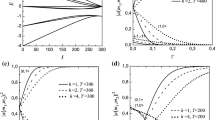Abstract
The aim of this paper is to investigate storing and recalling performances of embedded patterns on associative memory. The associative memory is composed of quaternionic multistate Hopfield neural network. The state of a neuron in the network is described by three kinds of discretized phase with fixed amplitude. These phases are set to discrete values with arbitrary divide size. Hebbian rule and projection rule are used for storing patterns to the network. Recalling performance is evaluated through storing random patterns with changing the divide size of the phases in a neuron. Color images are also embedded and their noise tolerance is explored.







Similar content being viewed by others
References
Hirose A (2003) Complex-valued neural networks: theories and applications. World Scientific, Singapore
Nitta T (2009) Complex-valued neural networks: utilizing high-dimensional parameters. Information Science Reference (IGI Global), New York
Jankowski S, Lozowski A, Zurada J (1996) Complex-valued multistate neural associative memory. Neural Netw IEEE Trans 7(6):1491–1496
Muezzinoglu M, Guzelis C, Zurada J (2003) A new design method for the complex-valued multistate hopfield associative memory. Neural Netw IEEE Trans 14(4):891–899
Isokawa T, Nishimura H, Matsui N (2009) An iterative learning scheme for multistate complex-valued and quaternionic hopfield neural networks. In: Proceedings of International Joint Conference on Neural Networks (IJCNN2009), pp 1365–1371
Isokawa T, Nishimura H, Saitoh A, Kamiura N, Matsui N (2008) On the scheme of quaternionic multistate hopfield neural network. In: Proceedings of SCIS and ISIS, Japan Society for Fuzzy Theory and Intelligent Informatics, pp 809–813
Isokawa T, Nishimura H, Matsui N (2013) Quaternionic neural networks for associative memories. In: Hirose A (ed) Complex-valued neural networks: advances and applications. Springer, New York, pp 103–131
Bülow T, Sommer G (2001) Hypercomplex signals-a novel extension of the analytic signal to the multidimensional case. Signal Process IEEE Trans 49(11):2844–2852
Isokawa T, Nishimura H, Kamiura N, Matsui N (2008) Associative memory in quaternionic hopfield neural network. Int J Neural Syst 18(2):135–145
Personnaz L, Guyon I, Dreyfus G (1986) Collective computational properties of neural networks: New learning mechanisms. Phys Rev A 34(5):4217
Kohonen T (1988) Self-organization and associative memory. Springer, Berlin
Lee DL (2006) Improvements of complex-valued hopfield associative memory by using generalized projection rules. Neural Netw IEEE Trans 17(5):1341–1347
Suzuki Y, Kobayashi M (2014) Complex-valued bipartite auto-associative memory. IEICE Trans Fundam Electron Commun Comput Sci 97(8):1680–1687
Author information
Authors and Affiliations
Corresponding author
Additional information
This work was presented in part at the 20th International Symposium on Artificial Life and Robotics, Beppu, Oita, January 21–23, 2015.
About this article
Cite this article
Minemoto, T., Isokawa, T., Nishimura, H. et al. Quaternionic multistate Hopfield neural network with extended projection rule. Artif Life Robotics 21, 106–111 (2016). https://doi.org/10.1007/s10015-015-0247-4
Received:
Accepted:
Published:
Issue Date:
DOI: https://doi.org/10.1007/s10015-015-0247-4




